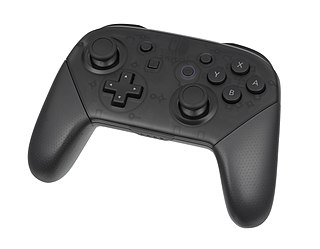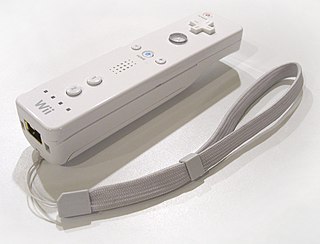
The Wii is a home video game console developed and marketed by Nintendo. It was released on November 19, 2006, in North America and in December 2006 for most other regions of the world. It is Nintendo's fifth major home game console, following the GameCube and is a seventh-generation console alongside Microsoft's Xbox 360 and Sony's PlayStation 3.

The Rumble Pak is a removable device from Nintendo which provides force feedback while playing video games. Games that support the Rumble Pak cause it to vibrate in select situations, such as when firing a weapon or receiving damage, to immerse the player in the game. Versions of the Rumble Pak are available for the Nintendo 64, the Nintendo DS, and the Nintendo DS Lite. A select few Game Boy Color and Game Boy Advance (GBA) games use a similar technology built into the game cartridge. Force feedback vibration has become a built-in standard feature in almost every home video game console controller since.

A gamepad is a type of video game controller held in two hands, where the fingers are used to provide input. They are typically the main input device for video game consoles.

The WaveBird Wireless Controller is a radio frequency-based wireless controller manufactured by Nintendo for use with the GameCube home video game console. Its name is a reference to Dolphin, the GameCube's codename during development. The WaveBird was available for purchase separately as well as in bundles with either Metroid Prime or Mario Party 4, which were exclusive to Kmart in the US.
The Virtual Console is a line of downloadable video games for Nintendo's Wii and Wii U home video game consoles and the Nintendo 3DS family of systems.

The Dual Analog Controller is Sony's first handheld analog controller for the PlayStation, and the predecessor to the DualShock. Its first official analog controller was the PlayStation Analog Joystick (SCPH-1110).

The Wii Remote, also known colloquially as the Wiimote, is the primary game controller for Nintendo's Wii home video game console. An essential capability of the Wii Remote is its motion sensing capability, which allows the user to interact with and manipulate items on screen via motion sensing, gesture recognition, and pointing which is used for the console, using accelerometer and optical sensor technology. It is expandable by adding attachments. The attachment bundled with the Wii console is the Nunchuk, which complements the Wii Remote by providing functions similar to those in gamepad controllers. Some other attachments include the Classic Controller, Wii Zapper, and the Wii Wheel, which has originally been used for the racing game, Mario Kart Wii.

Wii Music is a music video game developed and published by Nintendo for the Wii video game console. The game was released in Japan and North America in October 2008, and in Europe and Australia in the following month. Wii Music is part of both Nintendo's Touch! Generations brand and the Wii series.

The Sixaxis is a wireless gamepad produced by Sony for their PlayStation 3 video game console. It was introduced alongside the PlayStation 3 in 2006 and remained the console's official controller until 2008. The Sixaxis was succeeded by the DualShock 3, an updated version of the controller that, like the DualShock and DualShock 2 controllers, incorporates haptic technology – also known as force feedback. A Sixaxis controller can also be used with PSP Go via Bluetooth after registering the controller on a PlayStation 3 console.

The Wii Zapper is a gun shell peripheral for the Wii Remote. The name is a reference to and successor of the NES Zapper light gun for the Nintendo Entertainment System. It is mainly used to enhance controls for shooter games, including light gun shooters, first-person shooters, and third-person shooters.

The Classic Controller is a game controller produced by Nintendo for the Wii home video game console. While it later featured some compatibility with the Wii U console, the controller was ultimately succeeded by the Wii U Pro Controller. In April 2014, Nintendo discontinued production of both the Classic Controller and Classic Controller Pro.
Nyko is an American manufacturer of third-party accessories for various gaming consoles.

The GameCube controller is the standard game controller for the GameCube home video game console, manufactured by Nintendo and launched in 2001. As the successor to the Nintendo 64 controller, it is the progression of Nintendo's controller design in numerous ways. The contentious M-shaped design of its predecessor was replaced with a more conventional handlebar style controller shape; a second analog stick was added, replacing the C buttons with a C stick and the X and Y face buttons, last seen on the Super Nintendo controller, were reintroduced; the shoulder buttons were changed to hybrid analog triggers. A wireless variant of the GameCube controller known as the WaveBird was released in 2002.
The Nyko Frontman is a guitar controller produced by Nyko for several game systems to be used with the video games Guitar Hero and Rock Band. Depending on the version, its appearance is very similar to the Fender Telecaster (Wii) or the Gibson Explorer (PS2/PS3).

The Wii MotionPlus (Wiiモーションプラス) is an expansion device for the Wii Remote, the primary game controller for the Wii. The device allows more complex motion to be interpreted than the Wii Remote can do alone. Both the Wii and its successor, the Wii U, support the Wii MotionPlus accessory in games.

Pokémon Rumble is a beat 'em up video game in the Pokémon series for WiiWare.
Since the release of the Nintendo Wii, many aesthetic, ergonomic and functional accessories have been developed by third parties for the console’s controller, the Wii Remote.

The Wii U GamePad is the standard game controller for Nintendo's Wii U home video game console. Incorporating traits from tablet computers, the GamePad has traditional input methods, touchscreen controls, and motion controls. The touchscreen can be used to supplement a game by providing alternate, second screen functionality or an asymmetric view of a scenario in a game. The screen can also be used to play a game strictly on the GamePad screen, without the use of a television display. Conversely, non-gaming functions can be assigned to it as well, such as using it as a television remote.

The Wand is a line of game controllers released by Nyko as third-party alternatives to the official Nintendo Wii Remote. The original Wand duplicated the functionality of the Wii Remote, while the updated Wand+ added internal replication of the Wii MotionPlus for more advanced motion sensing, similar to Nintendo's later Wii Remote Plus. The Wand series also adds additional functionality through the use of a proprietary extension of the standard Wii Remote expansion port.















